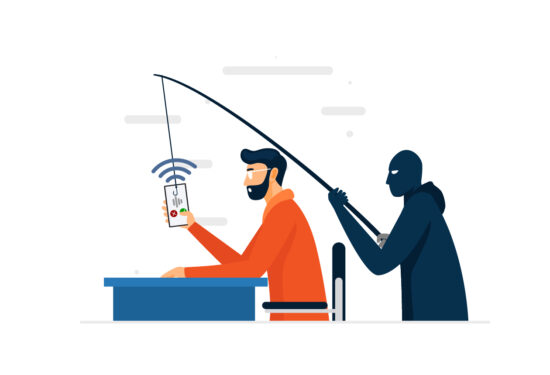Want To Say Goodbye To Passwords and OTP Codes?
Discover Push Authentication!
It is easy for your password to be compromised through phishing attacks, even if it meets the cybersecurity strong password standards and is difficult to predict So we must get to know the technique of Push based Authentication.
Some may recommend that you use Multi-Factor Authentication (MFA) to increase your security.
Multi-Factor Authentication (MFA):
MFA is the process of logging into your account through multiple steps.
It requires you to enter more information, not just your password.
But there is another obstacle that arises when using such technology.
When logging in to any application or website, you must fill in a One-Time-Passcode (OTP) code sent to your mobile phone or email.
True, this will increase the level of security, but at the same time, it will make the process much longer.
It consumes more time!
You must enter the OTP code correctly, and if you make a mistake, the website will re-send the OTP code again, and then you must enter it a second time.
You could have a problem with the email or SMS, so you will not be able to see the OTP code in the first place.
Is there another solution that combines ease of use while increasing security?
Come with us to learn about Push based Authentication technology.
What is it?
How does it work?
What are its special features?
Is it safer?
Learn About Push based Authentication.
Push based Authentication is one of the types of Multi-Factor Authentication (MFA).
It works by sending a notification to the user’s previously registered mobile phone, where the user can then click on the notification to agree or reject the login (Yes / No).

And it adds an extra layer of security by verifying that the user owns the mobile phone to which the notification was sent. Without access to the mobile device, an attacker cannot log in and hack into the account.
Push based Authentication is user-friendly, unlike other types of multi factor authentication solutions.
It only requires the user to approve or reject the request submitted to him/her without the need to a password or enter a security code, such as a One-Time Password (OTP).
Is The Security Level Sufficient?
Some may expect that Push Authentication is not completely secure, and this belief is due to its ease of use, which some people think might reduce the level of security.
But on the contrary, Push Authentication offers us a more secure method than other traditional methods related to MFA.
Push Authentication uses a fully encrypted communication method between the application and the user’s device, providing protection against Man in The Middle Attacks.
Push Authentication is also based on the Out of Band Authentication method, which means that the user’s mobile must be connected to the Internet to receive the notification, which helps to prevent unauthorized access attempts when the user is not connected to the Internet.
Are You Ready To Join The Push Era?
If you are looking to protect your employees and organization from Phishing and password-related attacks, our mPass product, specifically designed with Multi-Factor Authentication technology, offers full support and compliance with international standards for open authentication (OATH).

mPass integrates with most applications and systems and supports combining different methods for providing additional factors and passwords.
Special settings can also be set in many ways, such as SMS, soft tokens and Push based authentication features.
mPass has many uses, as it works to secure access to the company’s virtual network (VPN) for employees who work remotely, and it also works to secure the services companies provide through websites, among many other features.
Learn more about mPass from Cerebra
Share this article:
Popular

Revolutionize Enterprise Communication Platform with LinQ2
Revolutionize Enterprise Communication Platform with LinQ2 In today’s fast-paced business environment, enterprise communication platform is the backbone of success. Whether reaching customers, coordinating with employees, or automating notifications, having an effective enterprise communication platform is essential. Cerebra’s LinQ2 stands out as the ultimate solution, offering a multi-channel notification platform tailored for businesses of all sizes. Why Enterprise Communication Platform Is Essential for Business Growth? Efficient enterprise communication platform ensures businesses can stay connected with their customers and teams in real time. Poor communication systems often lead to missed opportunities, customer dissatisfaction, and delays in internal operations. Key Features of LinQ2 ...
11th Mar 2025
Deepfake in Phishing: Challenges and Solutions
In the era of advanced technologies, especially with the explosive adoption of Large Language Models (LLMs) and Generative Artificial Intelligence (GenAI), deepfake has emerged as one of the most significant challenges in cybersecurity. This technology relies on Artificial Intelligence, specifically deep learning and the use of GenAI, to create fake yet highly realistic content that is difficult to detect. Deepfake serves as a versatile tool spanning applications from entertainment to cybersecurity. However, its misuse can pose severe risks, especially in phishing schemes. What is Deepfake? Synthetic media refers to a technology that leverages deep learning algorithms to create ...
19th Dec 2024
AI Governance: Opportunities and Challenges in Cybersecurity
AI Governance: Opportunities and Challenges in Cybersecurity With the increasing reliance on AI technologies in various fields, AI Governance has become a key factor to ensure system integrity and data protection. This governance plays an essential role in enhancing confidence in modern technology and ensuring that it is used responsibly. It has been almost two years since OpenAI’s ChatGPT went viral, igniting widespread interest in artificial intelligence (AI) and setting off a wave of technological and investment growth in the field. Academic and technical investments in artificial intelligence: The advancements in AI since then have been staggering, with exponential increases ...
14th Nov 2024
Cyber Warfare Unveiled: Tracing the Journey from Espionage to Digital Combat
“Cyber Warfare: From Espionage to War A Journey Through Time” With the massive technological advancements, the boundaries of warfare have expanded to encompass cyberspace, where “cyber warfare” has emerged as an increasingly serious threat to individuals, institutions, and countries. The line between cyber and traditional wars has blurred for a while but recent activities in the region made it clear that cyberwars is becoming a dangerous and can lead to harming humans. In this blog, we will dive into a journey through the world of cyber warfare, seeking to understand its nature, history, impacts, types, evolution, and some solutions to ...
9th Oct 2024
Keeping Our Kids Safe Online
A Guide For Keeping Your Kids Safe Online Parents and all who are concerned about the well-being of our young kids in this digital world. Today we will discuss a topic of utmost importance: digital safety for kids. Yes, the Internet can be a very dangerous place for our young kids , especially with the spread of phishing scams. So, let us dive deeper and present to you, in this comprehensive article, a comprehensive guide on digital safety for kids. What every parent needs to pay attention to. Internet risks for kids: The internet has become a big part of ...
17th Jul 2024
Could you be hacked through Slack?
Could you be hacked through Slack? The usage of collaboration platforms such as Microsoft Teams and Slack has significantly increased, with nearly 80% of employees utilizing them. These platforms are designed to be convenient and easily manageable for daily conversations within organizations. However, what makes them easy and convenient also renders them vulnerable to cyber threats and attacks. In 2021, for instance, 780 gigabytes of data from the gaming giant Electronic Arts (EA) were breached through Slack! During the same year, a security vulnerability in Microsoft Teams was exploited to launch a widespread cyber attack on ...
12th Jun 2024
Tips To Be Cyber Protected While Traveling
Goodbye worry! A safe journey in the digital world With all the modern wonders of the digital world, we trust communication technologies on our journeys. There is no doubt that the travel experience is always more beautiful and enjoyable, but it can also pose a range of risks, especially when it comes to cybersecurity. Travelers may fall victim to phishing, Wi-Fi network spying, and theft of their personal data, which can make their journey filled with worries and tension. With the increasing prevalence of cyber threats, it is essential for travelers to follow some guidelines to protect their devices and ...
1st Apr 2024
The Difference Between Phishing Attacks
The Difference Between Phishing Attacks Phishing attacks are harmful attacks used by criminals to steal personal and financial information from individuals and businesses. Attacks on individuals and businesses are becoming more common as we use the internet and technology more often in our daily lives. Phishing attacks involve the use of dishonesty and fraudulent methods to fool consumers into believing they are interacting with the trustworthiness of an unsuspecting destination, such as banks, email companies, or social media platforms. But what is the difference between phishing attacks? How can individuals and organizations protect themselves from such attacks? That is what ...
17th Jul 2023
Understanding of the Vishing Meaning
Understanding of the Vishing Meaning Vishing, a combination of “voice” and “phishing,” is a sophisticated form of cybercrime that exploits voice communication to trick individuals and extract sensitive information. In this comprehensive guide, we will explore the meaning of it, the dangers associated with it, and effective methods to protect yourself against these malicious attacks. What is Vishing meaning? Vishing refers to the fraudulent practice of using telephone services to trick individuals into revealing personal and financial information. Scammers often pose as trusted organizations or individuals to gain their victims’ trust. By using social engineering tactics and manipulating ...
5th Jul 2023









